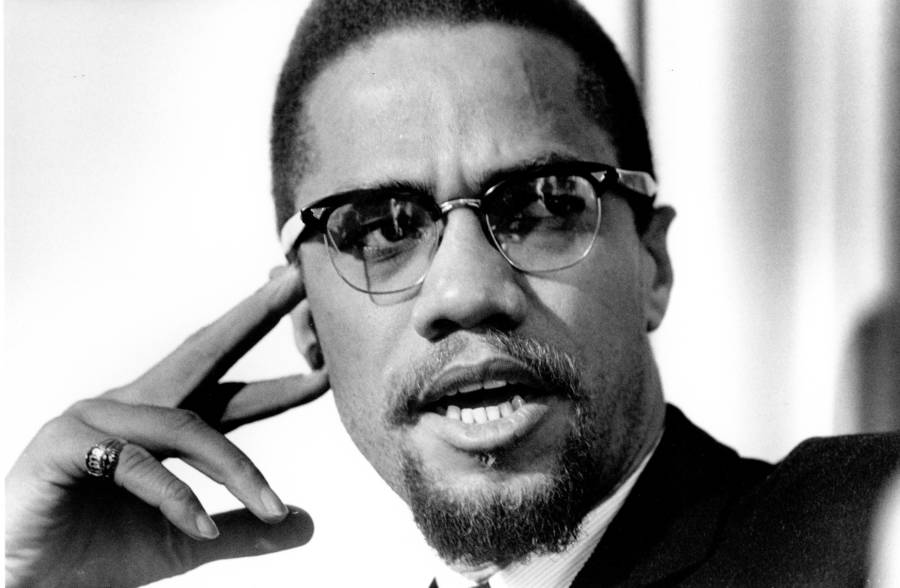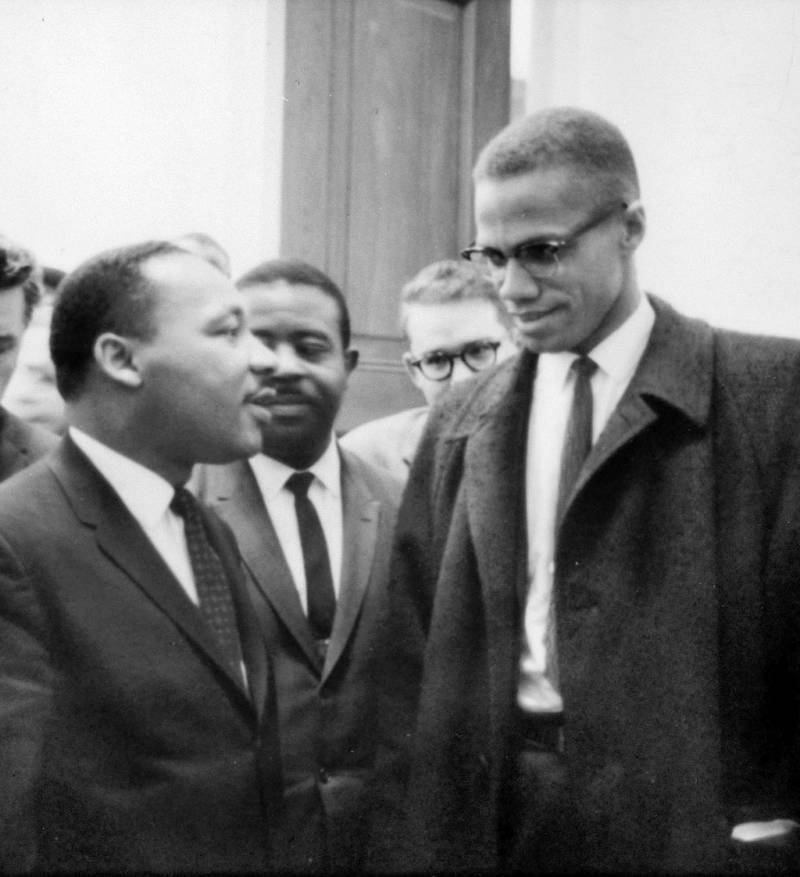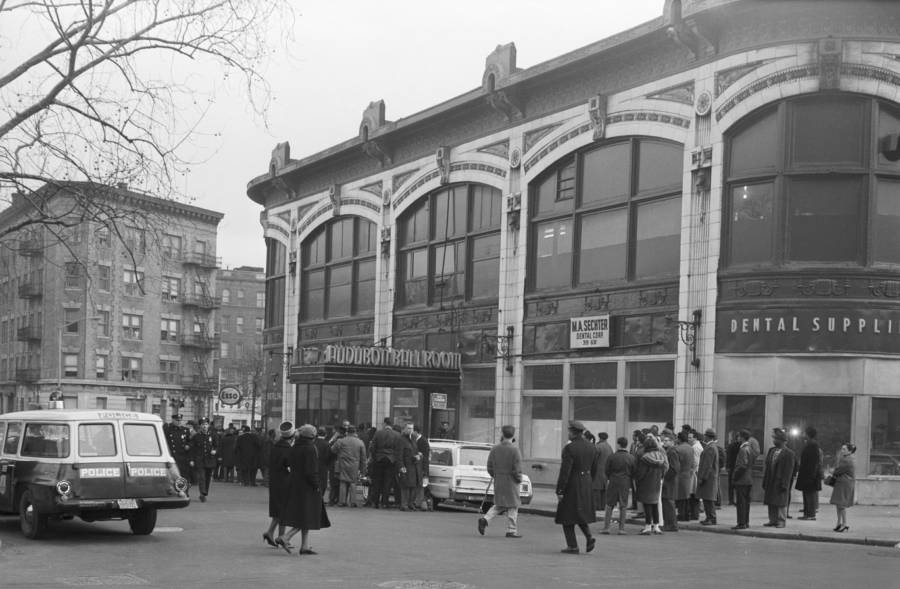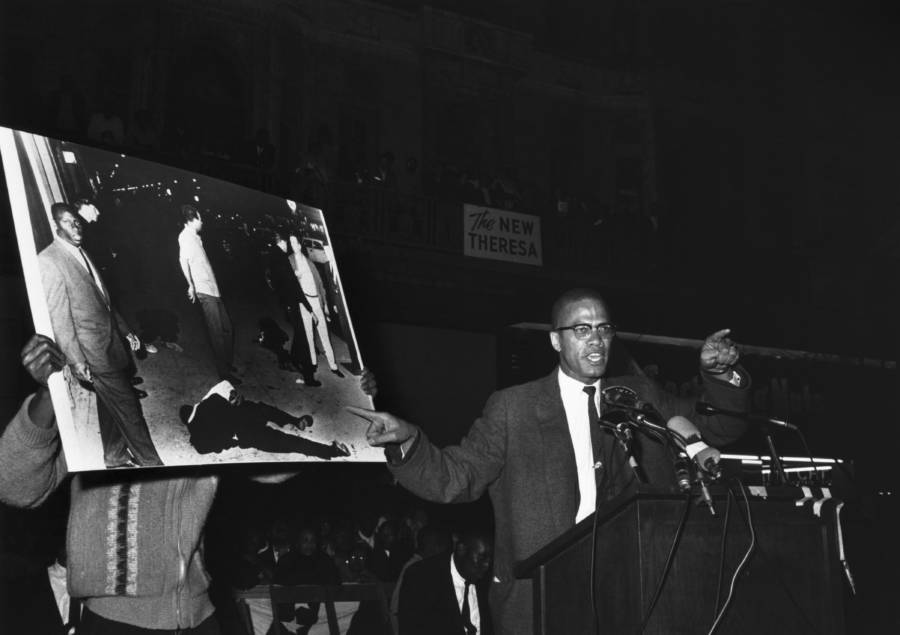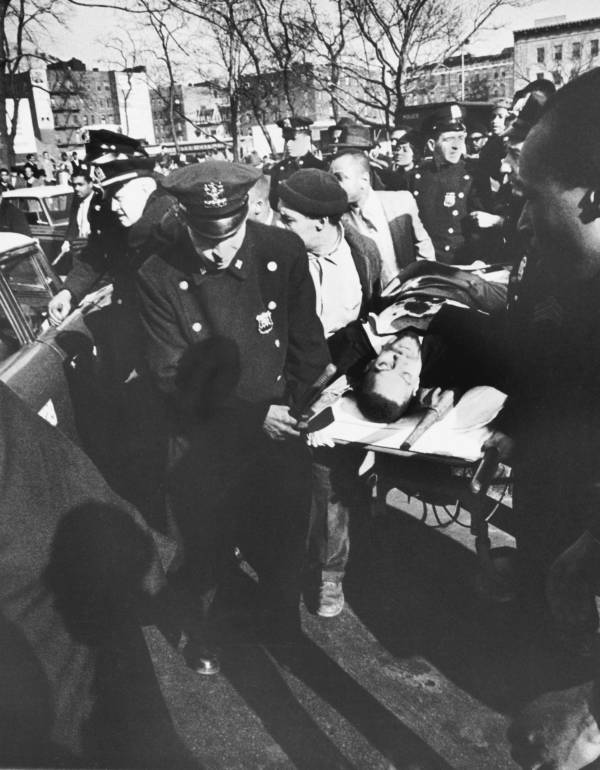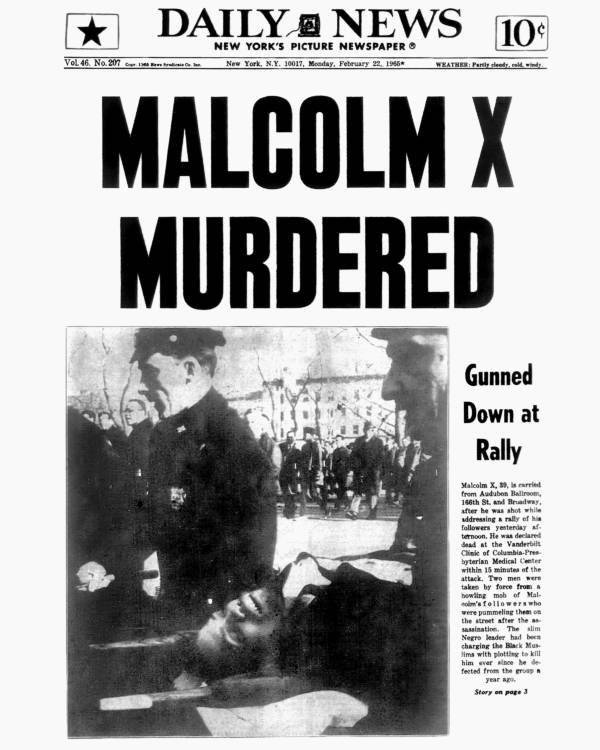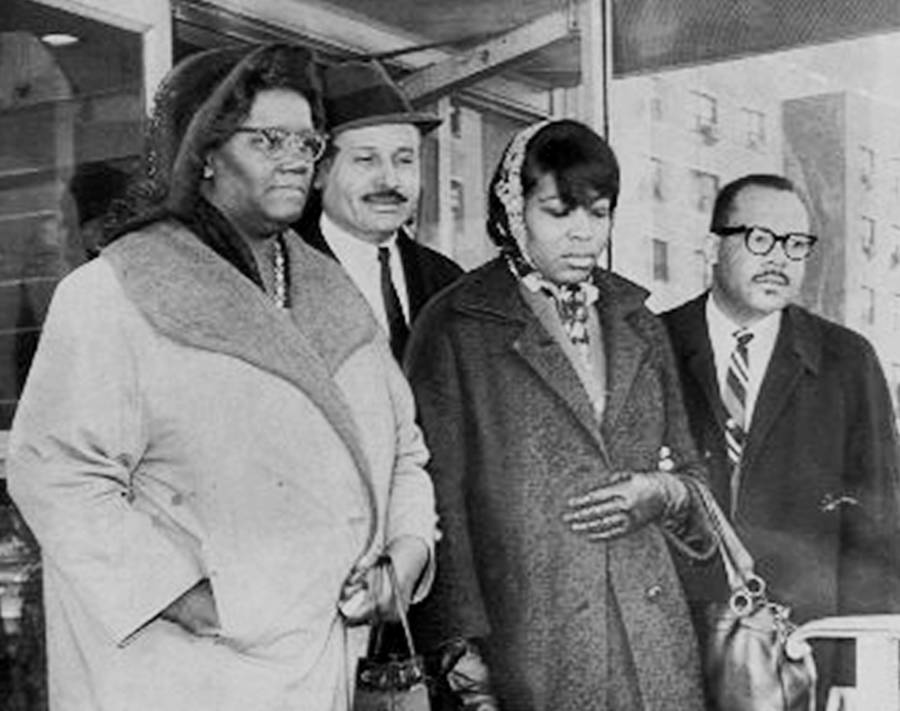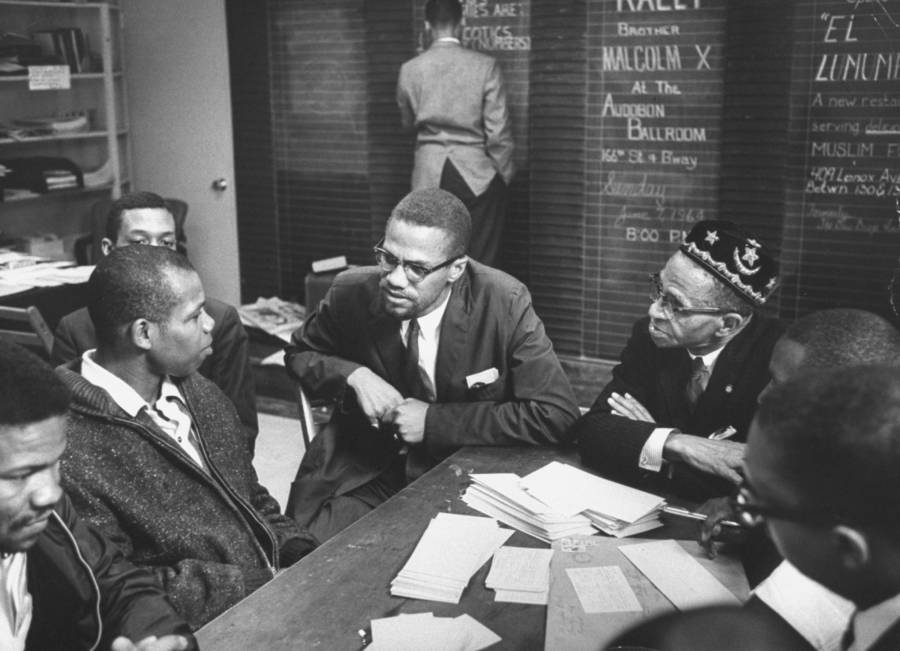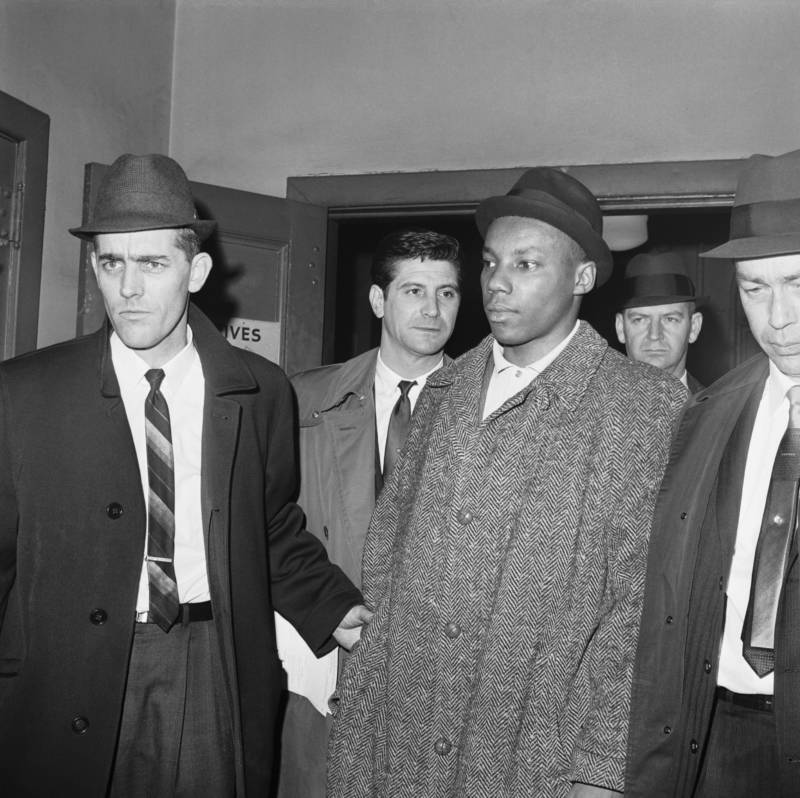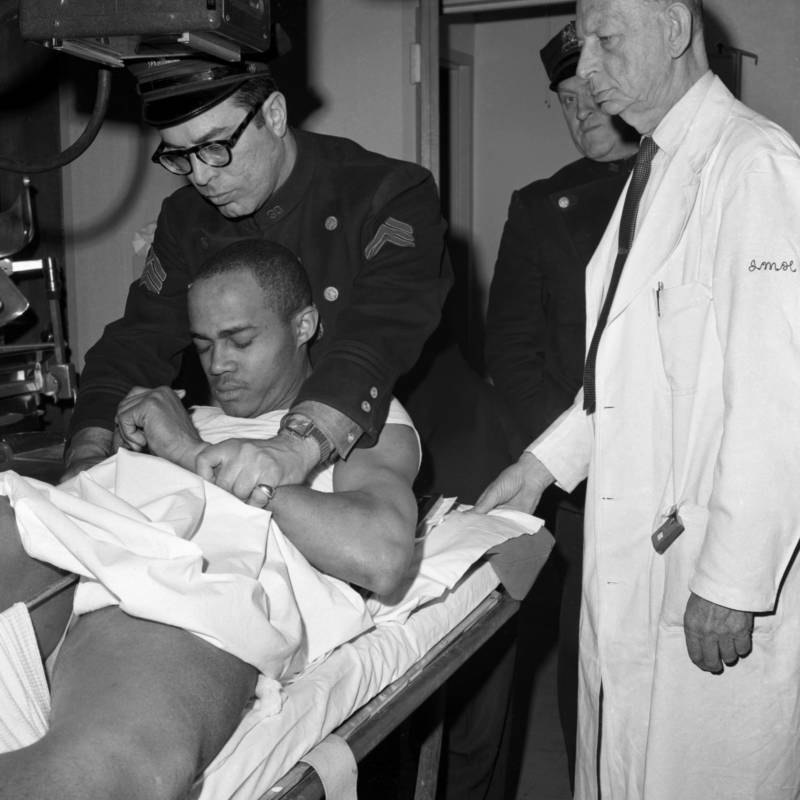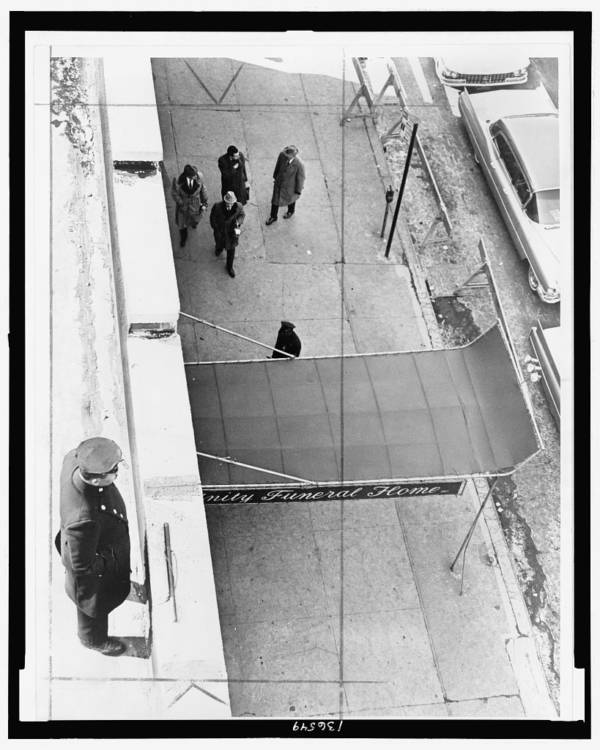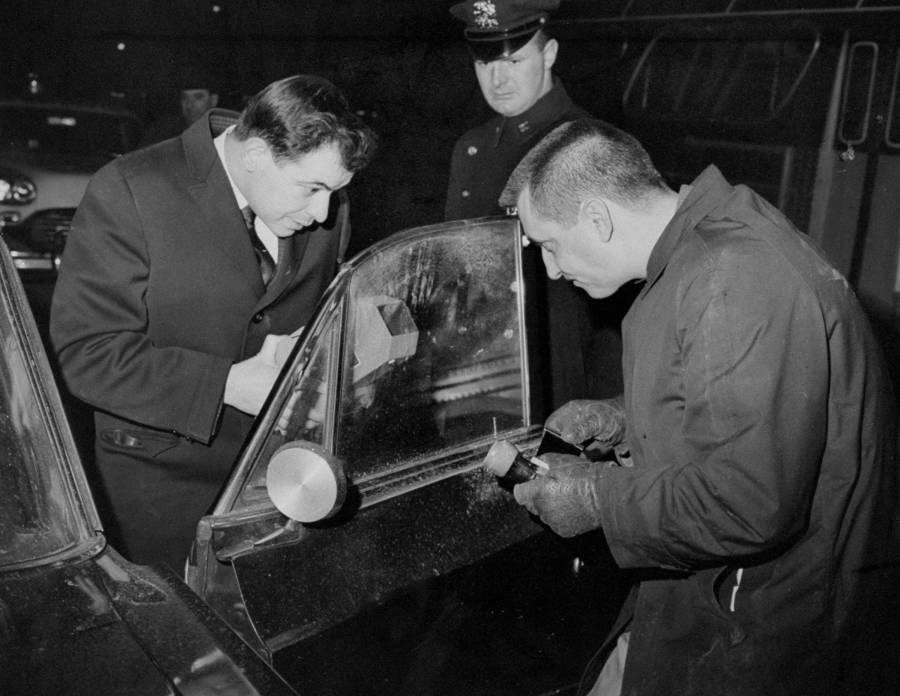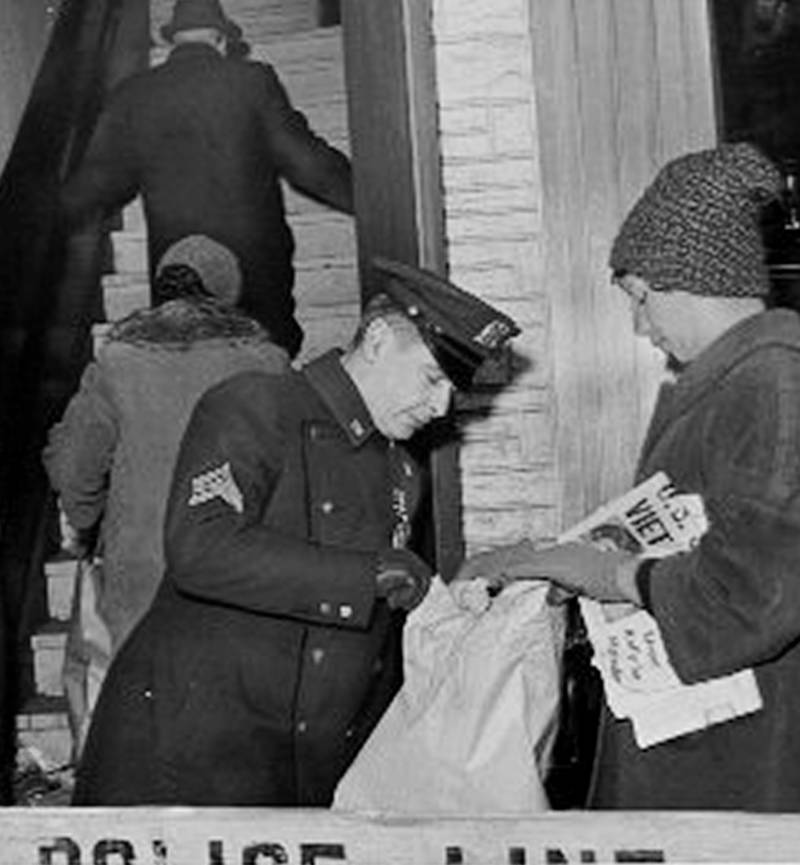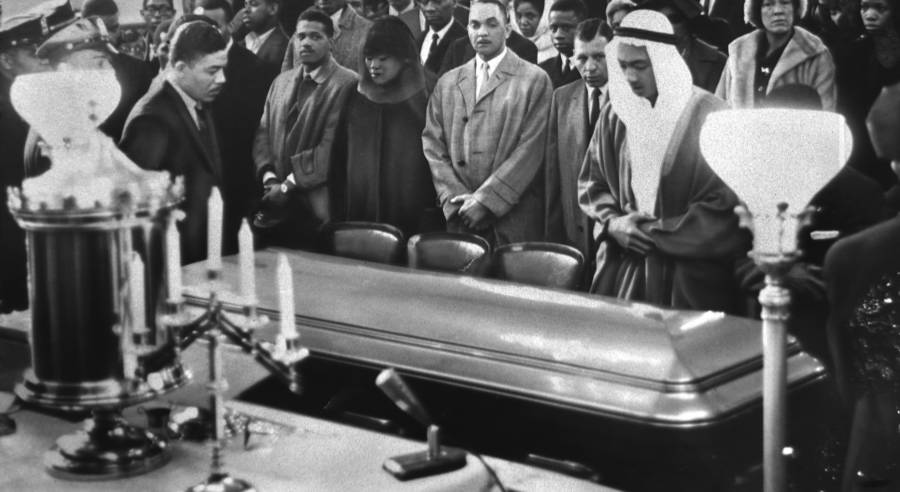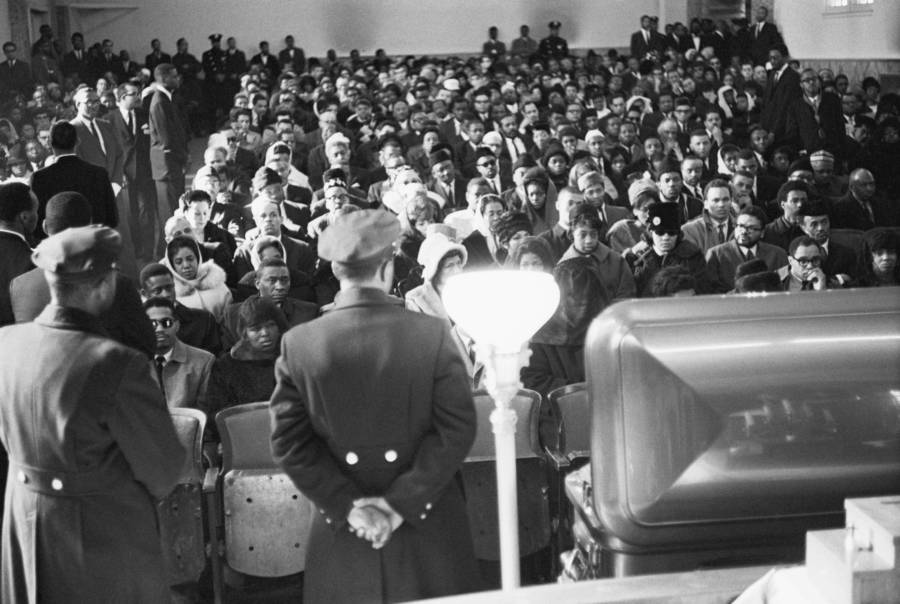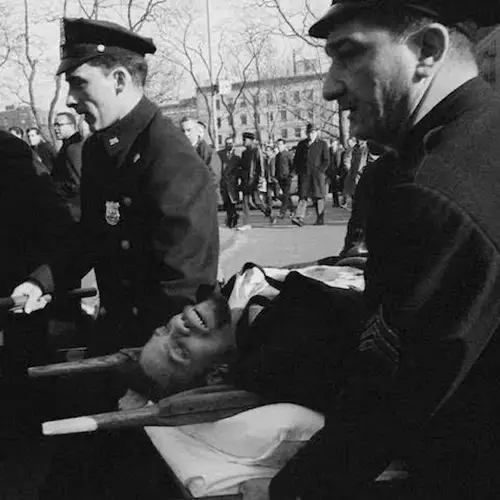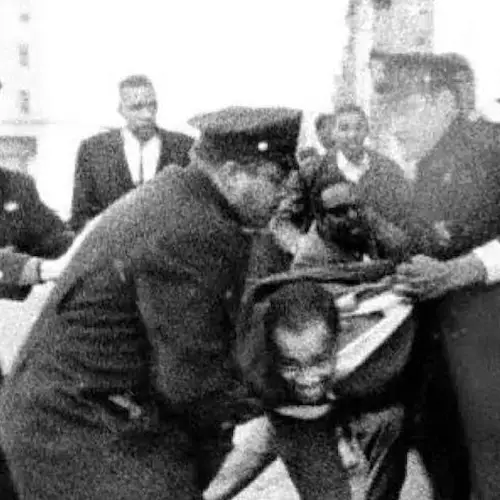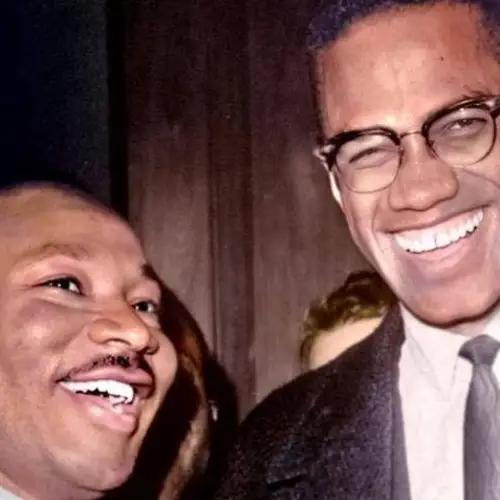On February 21, 1965, Malcolm X was killed while speaking at the Audubon Ballroom in New York City. To this day, the truth about his assassination remains unresolved.
On February 21, 1965, Malcolm X was assassinated at the Audubon Ballroom in the Washington Heights section of New York. As he was preparing to give a speech, a disturbance broke out in the crowd. In the confusion, three assailants rushed the stage and shot him multiple times. Almost immediately after he was rushed to the hospital, Malcolm X was dead.
During his lifetime, Malcolm X emerged as one of the most influential leaders of the civil rights movement thanks to his candor, intellect, and his incredible way with words. But the traits that made him an icon — and his belief that Black people should secure their freedom and equality “by whatever means necessary” — also garnered him plenty of enemies, both Black and white.
In the end, Malcolm X was murdered for his outspoken and courageous beliefs. But the mystery of exactly who killed Malcolm X and why has remained disturbingly murky in the more than 50 years since.
The investigation into Malcolm X’s murder was mired in mishandling and sabotage from the outset. Almost immediately, it seemed like the question of who killed Malcolm X wasn’t going to see a real answer.
Slowly, in the decades since, new details and revelations have emerged related to the assassination of Malcolm X that have upended the initial story. In recent years, in fact, more people than ever are asking who really killed Malcolm X — and finding that the answers aren’t what they first seemed.
See the most powerful photos from before and after the assassination of Malcolm X and then learn more about this historic case that has gone unresolved for more than a half-century.
Malcolm X's Early Experiences With Racism
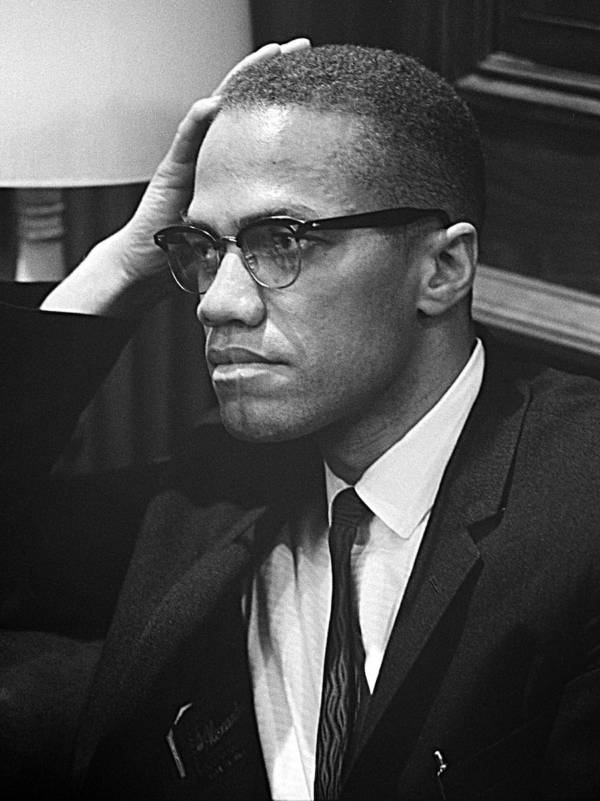
Wikimedia CommonsWhen he was young, Malcolm X's family was harassed by white supremacists.
Malcolm X was born Malcolm Little on May 19, 1925, in Omaha, Nebraska. He was brought up with six siblings in a household brimming with Black pride. His parents were active supporters of Marcus Garvey, who advocated for the separation of Black and white communities so that the former could build their own economic and political systems.
Malcolm's father, Earl Little, was a Baptist preacher and would host gatherings with other Garvey supporters in their home, which exposed Malcolm to the problems of race early in his childhood.
Because of his parents' activism, Malcolm's family was constantly harassed by the Ku Klux Klan. Just before Malcolm was born, the KKK shattered all their windows in Omaha. A few years later, after they moved to Lansing, Michigan, an offshoot of the Klan burned their house down.
When Malcolm was six years old, his father was killed after being struck by a streetcar. Authorities ruled it an accident, but Malcolm's family and the town's African-American residents suspected white racists had beaten him and placed him on the tracks to be run over.
Malcolm also lost other relatives to violence, including an uncle he said was lynched.
Years after her his father's death, Malcolm's mother Louise suffered a mental breakdown and was institutionalized, forcing Malcolm and his siblings to be separated and put in foster homes.
Despite his tumultuous childhood, Malcolm excelled in school. He was an ambitious kid who dreamed of going to law school. But by age 15 he dropped out after a teacher told him that becoming a lawyer was "no realistic goal for a nigger."
After dropping out of school, Malcolm moved to Boston to live with his older half-sister, Ella. In late 1945, after living in Harlem for a few years, Malcolm and four accomplices robbed the Boston homes of several wealthy white families. He was arrested the next year and sentenced to 10 years in prison.
Young Malcolm found refuge in the prison library, where he copied the entire dictionary and read books on science, history, and philosophy.
"In every free moment I had, if I was not reading in the library, I was reading on my bunk," Malcolm revealed in The Autobiography of Malcolm X. "You couldn't have gotten me out of books with a wedge... Months passed without my even thinking about being imprisoned. In fact, up to then, I never had been so truly free in my life."
Joining The Nation Of Islam
Malcolm's first brush with the Nation of Islam (NOI) was when his brothers, Reginald and Wilfred, told him about it while he was in prison.
Malcolm was skeptical at first — as he was of all religions. The religion preached that Blacks were innately superior and that whites were the devil. When Reginald visited Malcolm in prison to convince him to jin NOI, Malcolm wondered how whites could be the devil if, for example, they gave him $1000 every time he used to smuggle drugs in a suitcase. Wilfred remembered Reginald's account of their conversation some decades later:
"'Okay, let's just take a look at it. You don't believe they're the devil. What you brought back was probably worth maybe $300,000, and they gave you a thousand dollars, and you're the one who was taking the chance. If you got caught with it, you were the one who'd have gone to jail. After that, once they get it here, who do they sell it to? They're selling it to our people, and ruining our people with that stuff.' So then he looked at it from a different perspective and he saw what they meant when they said the white man was the devil. And then he decided he wanted to get involved."
Malcolm replaced his surname "Little" with an "X," an NOI tradition. "For me, my 'X' replaced the white slavemaster name of 'Little' which some blue-eyed devil named Little had imposed upon my paternal forebears," he later wrote. He started writing to Elijah Muhammad, leader of NOI, who was taken by Malcolm's intelligence.
Muhammad made Malcolm X minister of several NOI temples soon after Malcolm's release from prison in 1952.
Under his new name, he quickly worked on helping Muhammad expand his base of followers, traveling across the country to preach their message of a separate and powerful Black state.
"You are quoted as having said when an airliner crashed with a number of white people on board, that you were glad it happened," a white British reporter asked Malcolm X in the latter's first interview on British television in 1963. He responded that:
"The white race in this country collectively are guilty of these crimes that our people are suffering from collectively, and therefore they would suffer some collective disaster, collective grief. And when that plane crashed in France with 130 white people on it, and we learned that 120 of them were from the state of Georgia — the state that my own grandfather was a slave in — why, to me, it couldn't have been anything other than an act of God, a blessing from God. And I frankly and sincerely pray for similar blessings from Him to repeat themselves as often as He can."
It was statements like these that garnered Malcolm X and NOI unprecedented attention and made Malcolm a lightning rod of media criticism. Critics seized on his belief that white people were devils. Martin Luther King, Jr., whom Malcolm X dubbed a "chump" and a "20th century Uncle Tom," spoke out against Malcolm's "fiery, demagogic oratory in the black ghettos, urging Negros to arm themselves and prepare to engage in violence." King said such language "can reap nothing but grief."
But Malcolm X's words struck a chord with thousands of people. His popularity soon eclipsed Elijah Muhammad's, and, by some estimates, NOI's membership surged from 400 to 40,000 in just eight years.
Splitting With The Nation Of Islam
Starting in 1962, Malcolm X's relationship with the Nation of Islam became rocky.
Malcolm was shocked at Elijah Muhammad's unwillingness to take violent action against the Los Angeles Police after police officers shot and killed members of an NOI temple during a raid in April of 1962. Soon after, Malcolm discovered that Muhummad had been having extramarital affairs with NOI secretaries, which went against NOI teachings.
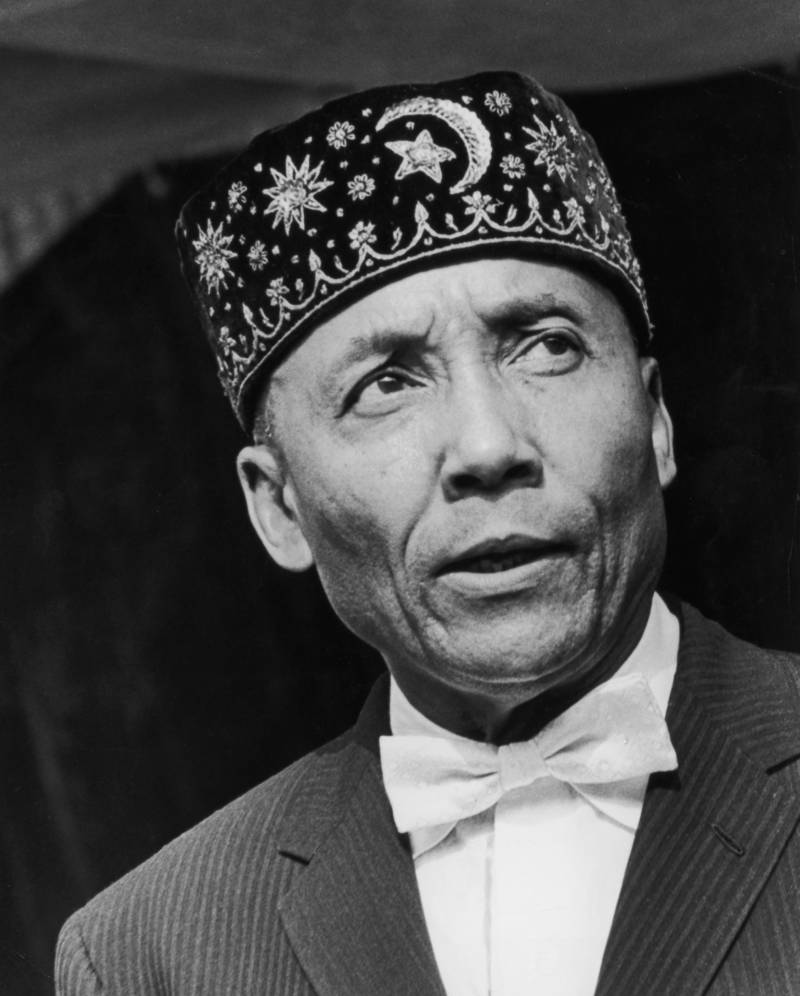
Hulton Archive/Getty ImagesElijah Muhammad, head of the Nation of Islam, in 1960.
Muhammad had also publicly disavowed Malcolm X from the organization following the latter's controversial remarks after President John F. Kennedy's assassination. Nine days after the president was killed, Malcolm likened his slaying to "chickens coming home to roost." Their relationship dissolved as quickly as it had been built which motivated Malcolm to separate himself from NOI to start his own movement.
Malcolm X announced his split from the Nation of Islam on March 8, 1964.
"Elijah Muhammad taught his followers that the only solution was a separate state for black people," Malcolm X later said during an appearance on the CBC. "As long as I thought he genuinely believed that himself, I believed in him and believed in his solution. But when I began to doubt that he himself believed that that was feasible, and I saw no kind of action designed to bring it into existence or bring it about, then I turned in a different direction."
His renunciation of the NOI would prove to have fatal consequences.
Malcolm X Charts His Own Path
After severing his ties with the Nation of Islam, Malcolm X maintained his Muslim faith and founded his own small Islamic organization, Muslim Mosque, Inc.
In April of 1964, after converting to the Sunni faith, he flew to Jeddah, Saudi Arabia to begin his Hajj, the Muslim pilgrimage to Mecca. It was thereafter that he earned his name, el-Hajj Malik el-Shabazz.
His pilgrimage changed him. He embraced the universal Islamic teachings of compassion and brotherhood. After seeing Muslims of every color in Mecca, Malcolm came to believe that "whites are human beings — as long as this is borne out by their humane attitude toward Negroes."
Still, he believed more strongly than ever that violence against and oppression of Blacks had to be met with violence in turn. "We will not only send [armed guerrillas] to Mississippi, but to any place where black people's lives are threatened by white bigots. As far as I am concerned," he told Ebony magazine in its September 1964 issue, "Mississippi is anywhere south of the Canadian border."
"Just as a chicken cannot produce a duck egg...the system in this country cannot produce freedom for an Afro-American," he charged, arguing that a national revolution was needed in order to dismantle systemic racism in the U.S.
He was particularly vocal against excessive police force toward African-Americans which remains a big issue to this day. He became a highly sought-after speaker on college campuses and on television.
The Assassination Of Malcolm X
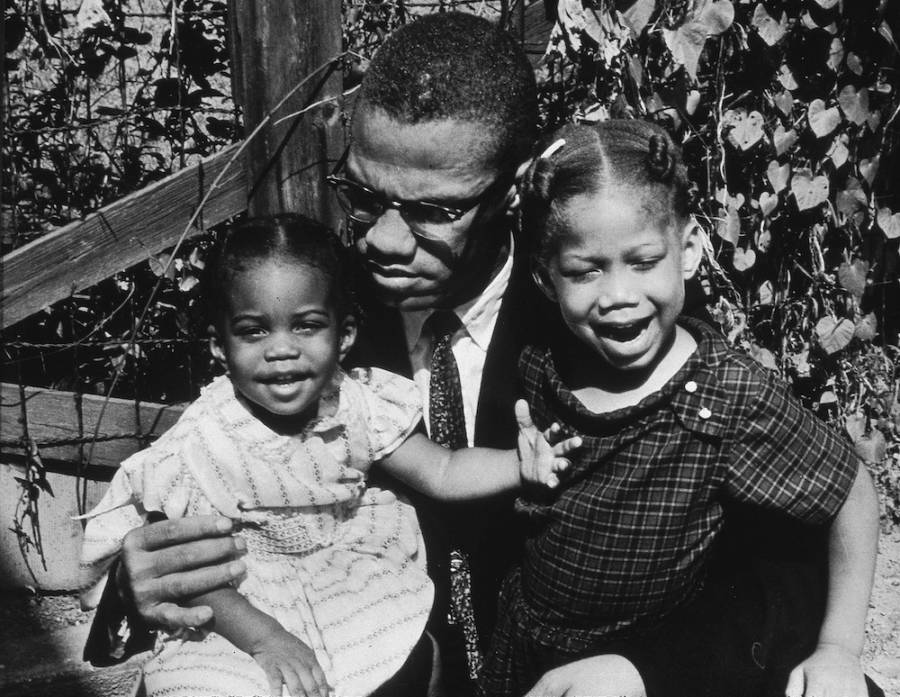
Getty ImagesMalcolm X with his daughters Qubilah (left) and Attilah two years before his assassination.
On Feb. 21, 1965, Malcolm X held a rally at the Audubon Ballroom in the Washington Heights neighborhood of New York City for his newly formed Organization of Afro-American Unity (OAAU), a non-religious group that aimed to unite Black Americans in their fight for human rights. His family's house had been destroyed in a firebomb attack only several days prior, but that did not stop Malcolm X from speaking to the crowd of 400 people.
One of the rally's speakers told supporters, "Malcolm is a man who would give his life for you. There aren't many men who would lay down their lives for you."
Malcolm eventually rose to the podium to speak. "Salam aleikum," he said. There was a commotion in the crowd — a bunch of drunks, some rally-goers assumed. And then Malcolm was shot, tumbling backward with blood on his face and chest.
Witnesses described multiple gunshots from multiple men, one of them "firing like he was in some Western, running backward toward the door and firing at the same time."
According to a first-hand report by UPI correspondent Scott Stanley, the barrage of shots continued "in what seemed like an eternity."
"I heard a terrifying volley of gunshots and screams and saw Malcolm bowled over by the bullets. His wife, Betty, cried hysterically, 'they're killing my husband'," Stanley recalled. Betty, who was pregnant at the time with the couple's twins, had thrown herself onto the rest of her children to shield them from the gunfire.
Malcolm X was shot at least 15 times.
Once the hysteria subsided and Malcolm X's body was carried away on a stretcher, the crowd began to attack the suspects right before the two men were taken into police custody. One of them had his left leg broken by Malcolm's supporters.
One of the assassins was Talmadge Hayer, better known as Thomas Hagan, who was a member of Temple Number 7 in Harlem, a Nation of Islam temple that Malcolm once led. Police said that Hagan had a pistol with four unused bullets at the time of his arrest.
The Aftermath Of Malcolm X's Death — And Who Killed Him
In the days following the assassination of Malcolm X, police arrested two additional NOI members suspected of being related to killing: Norman 3X Butler and Thomas 15X Johnson. All three men were convicted, though Butler and Johnson always claimed innocence and Hayer testified that they weren't involved.
In the 1970s, Hayer submitted two affidavits reasserting his claim that Butler and Johnson had nothing to do with Malcolm X's assassination, but the case was never reopened. Butler was paroled in 1985, Johnson was released in 1987, and Hayer was paroled in 2010.
Martin Luther King Jr. sent Malcolm X's wife, Betty Shabazz, a telegram after Malcolm X was killed.
The two prominent African-American leaders had often been at odds with their vastly different approaches to eradicate the country's structural racism. But they respected each other and shared the same vision of a liberated Black society.
King's letter read: "While we did not always see eye to eye on methods to solve the race problem, I always had a deep affection for Malcolm and felt that he had the great ability to put his finger on the existence and root of the problem."
A public viewing of his casket took place at the Unity Funeral Home in Harlem, where some 14,000 to 30,000 mourners paid their respects following Malcolm X's assassination. A funeral service followed at the Faith Temple of God in Christ.
Theories Surrounding Who Murdered Malcolm X And Why
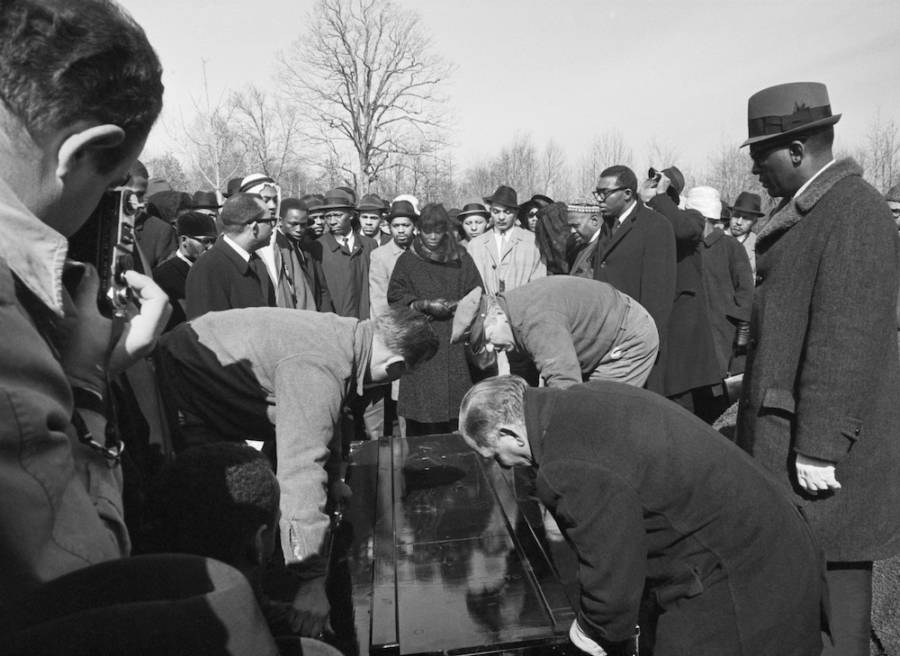
Wikimedia CommonsBetty Shabazz and others grieve as Malcom X's casket is lowered down.
As with the assassination of other famous figures, Malcolm X's demise boasts its fair share of theories about what happened that go beyond the official story.
Malcolm's own suspicions that he would be killed because of his beliefs were well documented. During a trip to the University of Oxford, he confided to British activist Tariq Ali that he would soon be dead.
"As I rose to leave, I hoped we would meet again. His response stunned me. He was doubtful that we would because 'they're going to kill me soon,'" Ali wrote about his encounter with the prominent speaker.
Ali added that after getting over his initial shock, he asked Malcolm X who was going to kill him and the outspoken Black leader was "in no doubt that it would be either the Nation of Islam or the FBI or both."
Three months later, Malcolm X was gunned down at the Audubon Ballroom.
In June 1964, FBI Director J. Edgar Hoover had sent a
In 2021, a confession letter that Wood wrote in 2011 surfaced when his cousin delivered to the family of Malcolm X. In the letter, Wood states he was part of an NYPD unit designed to sabotage civil rights leaders and that Malcolm X specifically was one of their targets.
Wood further claimed that he was asked to set up two of Malcolm X's bodyguards to be arrested just before the shooting: "It was my assignment to draw the two men into a felonious federal crime so that they could be arrested by the FBI and kept away from managing Malcolm X's door security on February 21, 1965."
In the wake of the letter's emergence, Malcolm X's family called for his murder case to be reopened. "Any evidence that provides greater insight into the truth behind that terrible tragedy should be thoroughly investigated," said Malcolm X's daughter Ilyasah Shabazz.
For decades, many have been calling for just that sort of thorough investigation. And in November 2021, Norman 3X Butler and Thomas 15X Johnson were exonerated in the murder of Malcolm X. Following a 22-month investigation, it was found that authorities withheld crucial information that would have kept the two men from being convicted.
In all, after more than a half-century, the quest for true justice in the case of Malcolm X's assassination continues on.
After learning about the tragedy of Malcolm X's assassination, read up on Martin Luther King Jr's dark side. Then, learn JFK assassination facts that most history buffs don't know.
